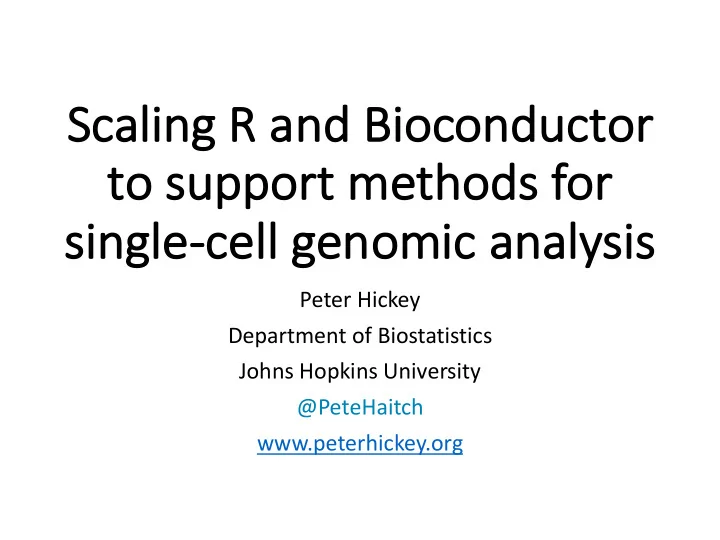

Sc Scaling R a g R and B Bioconduct ctor to to support methods for si single-ce cell g genomi mic a c analysis Peter Hickey Department of Biostatistics Johns Hopkins University @PeteHaitch www.peterhickey.org
Oh my, what big data you have! 80 GB 800 MB 8 MB Not just single-cell data Svensson V, Vento-Tormo R, Teichmann SA. Moore’s Law in Single Cell Transcriptomics, arXiv, 2017. Available: http://arxiv.org/abs/1704.01379
More data, more software + 42 preprints + 15 without publication Data from Luke Zappia (https://github.com/Oshlack/scRNA-tools)
More data, more software • https://github.com/seandavi/awesome-single-cell • > 80 software packages • https://github.com/Oshlack/scRNA-tools • Spreadsheet with description of > 120 software packages • Even within Bioconductor, lots of data structures
SingleCellExperiment: a Bioconductor class for single-cell data • Extends SummarizedExperiment
SummarizedExperiment
SummarizedExperiment
SummarizedExperiment
SummarizedExperiment Experiment metadata
SingleCellExperiment: a Bioconductor class for single-cell data • Davide Risso & Aaron Lun • Extends SummarizedExperiment • Adds slots for common single-cell data and operations • Spike-ins • Dimensionality reductions • Available on Bioconductor devel branch • Popular single-cell analysis packages are migrating to add support • scater • scran • MAST • zinbwave
That’s all lovely, but I’ve got BI BIG DA DATA • Yeah, sorta • Most single-cell genomics data are sparse data • 10X Genomics 1 million neuron scRNA-seq • HDF5 file • 30,000 rows (genes), 1.3 million columns (cells) • 93% zero • 136 GB as an ordinary matrix • Sparse Matrix • Limited to < 2 31 – 1 non-zero elements • Integer matrix stored as double Aaron Lun demonstrated analysis on desktop with 8 GB RAM
DelayedArray: For all your array- like needs • Hervé Pagès • DelayedArray is to arrays as tibble is to tables • Familiar matrix API • [ • dim() • t() • log() • … • But operations are delayed until data are explicitly realised • Data can be stored in a variety of backends • Works as an assay in a SummarizedExperiment (and derived classes)
Backends • In-memory • matrix ( base ) • Matrix ( Matrix ) • RleArray ( DelayedArray ) • Rle = run length encoding • On-disk • HDF5 ( HDF5Array ) • Data are in a HDF5 file, keep it in an HDF5 file • matter ( matterArray ) • Kylie A. Bemis (Northeastern University)
Backends Class/backend Package Size in memory Size on disk DelayedArray with matrix base 800 MB 0 MB DelayedArray with dgCMatrix Matrix 951 MB 0 MB RleMatrix (solid) DelayedArray 1001 MB 0 MB RleMatrix (chunked) DelayedArray 634 MB 0 MB HDF5Array (default compression) HDF5Array < 10 kB 165 MB matter matterArray < 10 kB 800 MB • Fairly straightforward to add new backends
DelayedMatrixStats • Me • Inspired by matrixStats (Henrik Bengsston, CRAN) • Functions for columns and rows operations on DelayedMatrix (2D DelayedArray) objects • colSums2(), rowSums2() • colMeans2(), rowMeans2() • colSds(), rowSds() • colLogSumExps(), rowLogSumsExps() • … (33 more methods) • Idea: Support matrixStats API for DelayedMatrix and derived classes • Aim 1: General methods to work on arbitrary DelayedMatrix • Aim 2: Optimised methods for specific backends
beachmat • Aaron Lun, Mike Smith, Hervé Pagès • Unified C++ API for (most) DelayedMatrix backends • get_col(), get_row() • set_col(), set_row() • Currently: matrix, Matrix, RleMatrix, HDF5Matrix
restfulSE • Vincent Carey • Proof-of-concept • HDF5 server backed SummarizedExperiment • Data live on remote server, stored in HDF5 file • RESTful API • Data returned as binary (better) or JSON • No server-side computation (yet)
Key points • Starting point for a lot of genomics data analysis is a array of numbers • Bioconductor strength is semantically rich data structures for array-like data • SummarizedExperiment -> SingleCellExperiment • Assay data doesn’t have to be an ordinary array • Supporting general array-like data with DelayedArray and different backends • DelayedMatrixStats, beachmat, HDF5 Server • R/BioC’s strength is supporting interactive exploratory data analysis, rich data structures, interoperability
Links and contact • Packages : • https://bioconductor.org/packages/SingleCellExperiment/ • https://bioconductor.org/packages/DelayedArray/ • https://bioconductor.org/packages/HDF5Array/ • https://bioconductor.org/packages/beachmat/ • https://bioconductor.org/packages/matter/ • https://github.com/PeteHaitch/matterArray • https://github.com/PeteHaitch/DelayedMatrixStats • https://github.com/vjcitn/restfulSE • Slides : http://peterhickey.org/presentations/ • GitHub & Twitter : @PeteHaitch
Recommend
More recommend